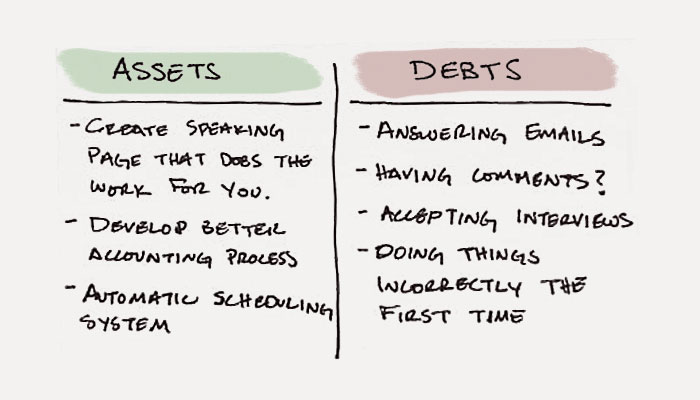Most productivity strategies focus on short-term efficiency, like how to get more done each morning or workday. But certain strategic choices impact our time on a larger scale, like investments and debts. Here’s how to think in terms of time assets and time debts.
Picture: Viktoria Kazakova (Shutterstock)
One notorious anecdote that can illustrate the idea of time assets involves Steve Jobs. Late in his career, Steve Jobs famously drove his car without a licence plate.
There were all sorts of theories about why Jobs decided to drive without tags. Some people said he didn’t want to be tracked. Others believed he was trying to make a game of avoiding parking tickets. Jon Callas, a former computer security expert who worked for Apple, revealed a different reason.
According to Callas, Steve Jobs discovered a loophole in the California vehicle registration laws. Anyone with a new car had up to six months to get a proper licence plate for their new vehicle. During the first six months, however, you could simply drive the vehicle without a licence plate.
Once he realised this, Jobs arranged a special leasing agreement with his Mercedes dealer so that every six months he would drop off his current car and receive a new Mercedes SL55 AMG to replace it. This meant that he never drove a car older than six months and he never had to go to the Department of Motor Vehicles to get a licence plate. [1]
After hearing the story, many people responded by saying something like, “I guess that’s what you do when you have a lot of money.” And, to be fair, it is true that this licence plate strategy isn’t reasonable for most people on the planet. If you look deeper, however, you’ll notice that something else was happening: Steve Jobs was building a “Time Asset”.
Time Assets vs Time Debts
Most productivity strategies focus on short-term efficiency: how to manage your to-do list effectively, how to get more done each morning, how to shorten your weekly meetings, and so on. These are all reasonable ideas.
We often fail to realise, however, that there are certain strategic choices that impact our time on a larger scale. These choices can be categorized as Time Assets or Time Debts, which are two concepts I learned from Patrick McKenzie. [2]
Time assets are actions or choices you make today that will save you time in the future.
Software is a classic example of a time asset. You can write a program one time today and it will run processes for you over and over again every day afterward. You pay an upfront investment of time and get a payoff each day afterward.
The car leasing system that Steve Jobs developed is another example of a time asset. It took him some time to find a loophole and arrange a repeatable leasing system, but his process rewarded him with additional time and less hassle every six months. Of course, that’s a rather elaborate way to avoid standing in line at the DMV.
Time debts are actions or choices you make today that will cost you additional time in the future.
Email is a time debt that most people participate in each day. If you send an email now, you are committing to reading the reply or responding with an additional message later. Every email you send creates a small debt that you have to pay back at a later time.
This is not to say that all time debts are bad. Perhaps you enjoy serving on your school committee or volunteering with a local organisation. However, when you make these commitments, you are also creating a time debt that you will have to pay at some point. Sometimes the debts we commit to are worth sacrificing for, many times they are not.
Time Assets in Real Life
I wrote down a short list of time assets and time debts for my business. Here are a few I came up with.

Assets
- Speaking. I can create a speaking page on my website that answers common questions and qualifies the right kind of people. This could include a descriptive Frequently Asked Questions section or a better sign up form. The goal of the system is to set clear expectations and answer common questions that I usually have to answer via email.
- Accounting. By setting clear rules for my bookkeeper and accountant, we can develop a system for automatically tagging certain expenses and transactions each month, which minimises the need for me to manually approve repeated transactions.
- Scheduling. Booking calendar appointments, calls, and interviews requires a lot of email. Using software like ScheduleOnce eliminates this problem and lets people choose from a pre-selected list of available times.
Debts
- Email. The more email I answer, the more email I generate, and the more time I’m committing to answering them later
- Interviews. As a public speaker and writer, I often get asked to do interviews. At first, I said yes to every interview that came my way. Today, I typically do three to five every week. Saying yes to every interview has become a time debt.
- Low quality work. If you don’t edit your article now, you’ll have to fix the grammar later. If you write sloppy code now, you’ll have to debug it later. If you create a poor product in the beginning, you’ll have to service customers and process refunds later. Every low quality piece of work is a time debt that you have to pay back. To quote Jon Wooden, “If you don’t have time to do it right, when will you have time to do it over?”
A System For Your Time
Systems are more important than goals, and Time Assets are a perfect example of why this is true. Each Time Asset that you create is a system that goes to work for you day in and day out.
If your schedule is filled with Time Debts, then it doesn’t matter how hard you work. Your choices will constantly put you in a productivity hole. However, if you strategically build Time Assets day after day, then you multiply your time exponentially.
Driving a car without a licence plate might seem like an extreme way to save time (and of course, you could argue that he spent more time exchanging cars than it would take to simply get a licence plate), but what matters is the level of strategic thinking that most people never embrace. This isn’t an approach that only works for Steve Jobs. It works for all of us.
Time Debts need to be paid. Be careful how you choose them. Time Assets pay you over and over again. Spend more time creating them.
Time Assets vs. Time Debts: A Different Way of Thinking About Productivity [James Clear]
James Clear writes about science-based ideas for living a better life and building habits that stick. If you enjoyed this article, then join his free newsletter.
[1] “Mystery solved: Why Steve Jobs’ car never had a licence plate” by Aayush Arya. October 27, 2011. [2] The idea for Time Assets and Time Debts originally came from Patrick McKenzie, a programmer and friend of mine. You can read his great productivity post on the concept here.

Comments